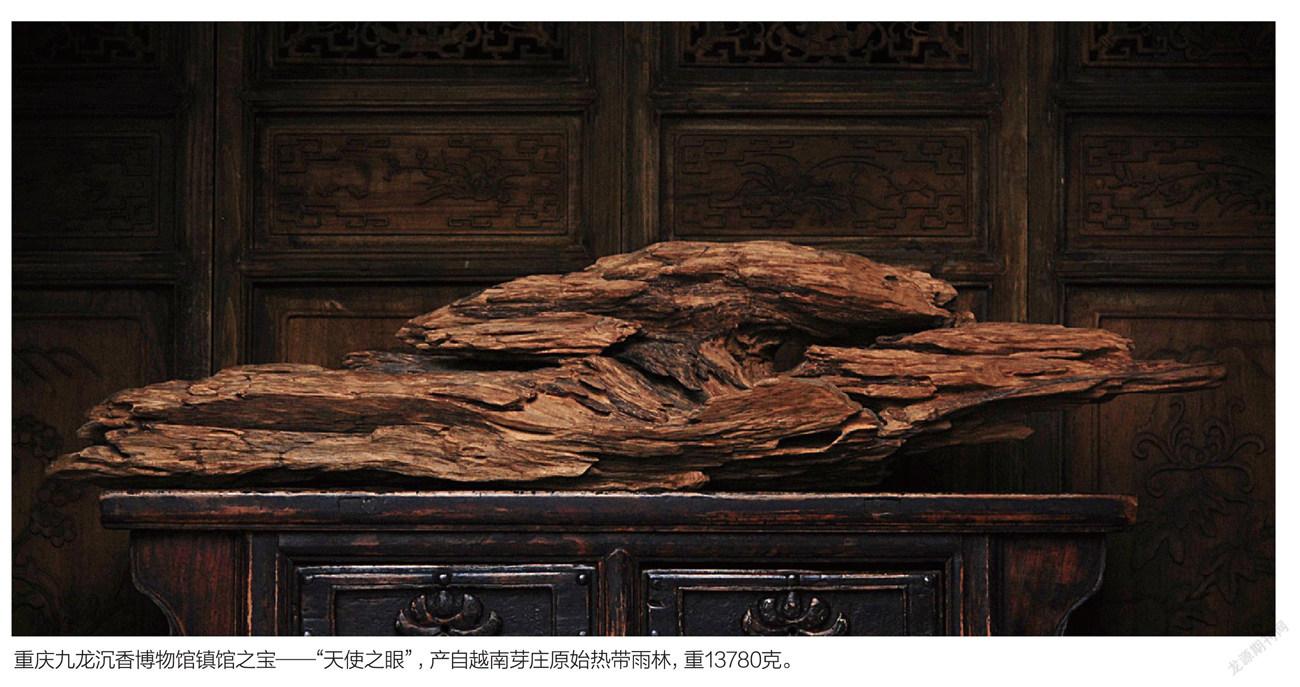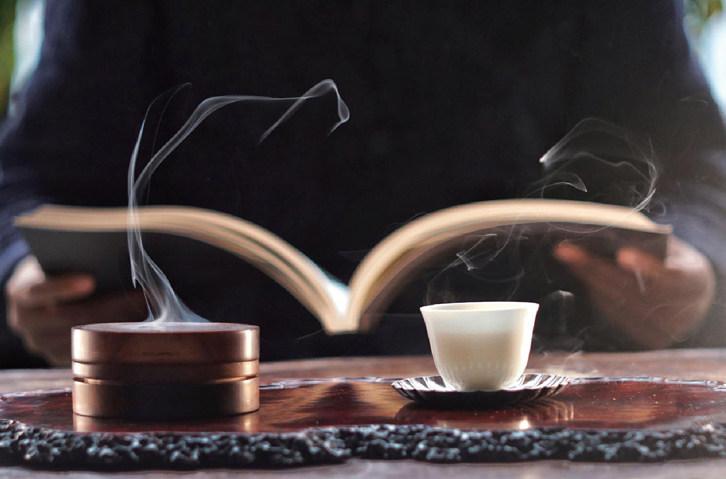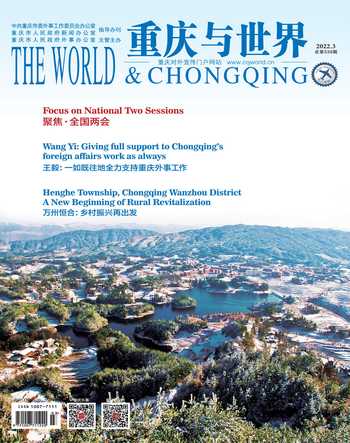九龙沉香&琉璃博山炉香事情未了
杨艳





Creating Antique Artifact in New Way and Remaining True to Art
“Behold the censer and the agilawood in fire, two wreaths of smoke combine and rise higher and higher.”
In the poem A Love Song, the great Chinese poet Li Bai wrote that censer is a must have for refined scholars in ancient time. The elegant and unique incense burner is placed beside the table, and the aroma spreads, creating a hazy fairyland.
In the exhibition hall of Chongqing Jiulong Agilawood Museum, several glaze Boshan Censers of different colors are clear and transparent. The censer cover is hollowed out and chiseled into overlapping mountain shapes, with chiseled rare birds and lifelike animals, shining with a warm and restrained luster. The colored glaze Boshan Censer has been selected as 2021 “Chongqing Gifts for Foreign Affairs”.
As early as the Han and Jin dynasties in China, the Boshan Censer became a common incense burner in the court and noble life, and its artistic attainments and casting technology represented the peak of that time.
In order to reproduce the craftsmanship and charm of the Boshan Censer, Ling Kun, curator of the Jiulong Agilawood Museum, referred to a large number of ancient books and materials, tested with a lot of materials, and used 3D scanning, printing prototypes and the ancient method of glazed dewaxing and finally replicated the artifacts.
“The colored glaze originates from foreign countries. It is crystal clear and radiant and is more charming when integrating with Chinese culture.” Ling Kun said that each colored glaze Boshan Censer must be cast one by one, and the yield rate is only 70%, which cannot be recycled for remaking. Every bubble and every line in the glaze are unique and cannot be duplicated.
Taste of Time and Incense of Years
The incense burners are created to go with incense.
People living in the ancient time were expert in discovering the taste of nature. With the thriving “Silk Road” trade route, spices gradually became the “protagonist” of international trade. In the middle and late Song Dynasty, the three items, namely incense burner, incense box and the tool bottle, gradually became a set for incense burning. In the Ming Dynasty, Zheng He made seven voyages to the West and spices together with silk, tea and porcelain, became important commodities and medium for cultural exchanges between China and foreign countries. Chinese people love and admire incense, and incense has gradually merged with Chinese traditional culture, creating many wonderful stories.Since the Tang and Song dynasties, burning incense, hanging paintings, making tea and enjoying music are called the “four arts for literati”. Among them, incense embodies the wonderful taste of incense culture. In the smell, there are elements that are connected with the lifeblood of classical culture.
Today, the Jiulong Agilawood Museum uses agilawood as a medium to tell the story of China to the world. “At present, the museum houses more than 500 groups of agilawood collections from incense-producing regions of Vietnam, Indonesia, and Malaysia, as well as hundreds of incense burners from the Han, Tang, Song, Yuan and Ming Dynasties in China.” Ling Kun said that the museum has 9 parts. Systematic introduction and stories behind agilawood will be told through several chapters such as the evolution history of incense burners in the past dynasties, the systematic classification of agilawood, the display of the core production areas of agilawood, the art of agilawood statues, the identification of true and false, the display of ancient methods of blending incense and incense materials, and contemporary agilawood cultural and creative works.
Making Incense with Ingenuity and Promoting Incense Culture
Stepping into the museum, you will find the “preparation room” of incense. It is more like a showroom of “nature”, with a dazzling array of spices like works of art.
Ling Kun is not only a collector of agilawood for many years, but also a well-known incense maker in the industry. He first proposed the classification standard of modern agilawood and the norm of “nine essentials of incense”. With both theoretical knowledge and know-how, he is an expert in incense aesthetics and collection.
The process of making incense may seem simple, but it contains profound knowledge. With the same raw materials, different proportions and grinding processes can bring about different quality of incense. “The unique blending incense in Chinese incense culture is about concocting and blending different spices. According to their own aesthetic ideas, different settings require different blending incense, such as poetry, calligraphy, painting, dancing, music and tea, promoting the progress of Chinese incense culture.” Ling Kun’s reputation in the industry comes from his proficiency in blending incense materials and their proportions. “Making traditional blending incense requires not only natural spices as raw materials, but also formula, strict processing method and production process. The process of making incense must follow the ancient method and integrate the nature of mind into it.”
In June 2019, the traditional incense-making of Chongqing Jiulong Agilawood Museum was included in the 6th Chongqing Municipal Intangible Cultural Heritage List.
This “preparation room” is also often turned into a “recording room”. The Chongqing Jiulong Agilawood Museum shows netizens the history, culture, production techniques, and incensing methods of various spices through the “Xiaohongshu” platform. In less than a year, it has more than 180,000 likes.
Chongqing Jiulong Agilawood Museum has harvested many honors since its establishment 6 years ago, including 2018 China Tourism Cultural Commodities Bronze Award, Chongqing Cultural and Creative Products Exhibition “Best Creativity Award”, 2021 China Tourism Commodity Competition Gold Award, 2021 “Chongqing Gifts” Tourism Commodity Design Competition Gold Award. From the joint launch of the exhibition Lingering Incense and Affection with the China Three Gorges Museum in Chongqing, and the launch of The Silk Road Incense - The Origin of Chinese Incense Culture Exhibition jointly launched with the China Three Gorges Museum in Chongqing, the Yunnan Provincial Museum and the Shanxi Museum, to holding meetings in the museum, giving lectures in colleges and universities, conducting joint exhibitions, etc., and making frequent appearances in festival events such as “China Tourism Marketing Conference”, “World Leisure Expo” and “Global Travel Agents Conference”, the ancient skills of making incense is walking out of the show window of the Chongqing Jiulong Agilawood Museum against the backdrop of economic globalization and cultural diversification, looking for and interpreting the spiritual pursuit and artistic charm behind the Chinese incense culture with a new attitude. It also reflects the “Belt and Road” spirit of openness and cooperation and making the spirit of mutual learning more long-lasting.
Photos by Chongqing Jiulong Agilawood Museum
古器新作 守造物心
“博山炉中沉香火,双烟一气凌紫霞。”
诗人李白在《杨叛儿》中道出了香炉在古代是文人雅士的标配:典雅别致的香炉摆在案几桌边,炉中香气氤氲蔓延,营造出朦胧的人间仙境……
重庆九龙沉香博物馆展厅内,几尊不同颜色的琉璃博山炉清透明澈,炉盖镂空雕凿成重叠的山形,附有珍禽异兽栩栩如生,闪烁着温润内敛的光泽。琉璃博山炉入选2021“重庆好礼·外事礼品”。
据了解,博山炉早在中国汉、晋时期就成为宫廷与贵族生活中常见的焚香器具,其艺术造诣与铸造技术代表着当时的顶峰之作。
为了重现博山炉的工艺与气韵,九龙沉香博物馆馆长凌鲲查阅了大量古籍资料,耗费了大量的物料,通过3D扫描、打印原型,以古法琉璃脱蜡的制造工艺,才最终定型而成。
“自外国传来的琉璃晶莹剔透,光华流转,与中国文化融合后,更是迷人。”凌鲲说,每尊琉璃博山炉须独立铸模,成品率只有70%,不可回收再造。琉璃中的每一颗气泡、每一处线条都是独一無二,无法复制。
时光知味 岁月沉香
所谓香具,依香而生。
古人善于发掘自然的味道。随着“丝绸之路”贸易路线的繁荣,香料逐渐成为国际贸易的“主角”。宋代中后期,以香炉、香盒、箸瓶为主体的炉瓶三事,渐成定制。明代郑和七下西洋,香料为大宗贸易品,与丝绸、茶叶、瓷器共同成为中外文化交流的重要媒介。中国人爱香、敬香,香逐渐与中国传统文化融在一起,演绎出许多精彩故事。唐宋以来,焚香、挂画、点茶、听琴,称为“文人四艺”。其中,香烟氤氲,凝聚着香文化的意趣美妙。气味之中,潜藏着与古典文化血脉相连的元素。
而今,九龙沉香博物馆就以沉香为媒,向世界讲述着中国故事。“目前馆内收藏了来自越南、印尼、马来西亚等众多产香区的沉香藏品500余组,以及中国汉唐宋元明时期的香具香炉等藏品数百件。”凌鲲介绍,博物馆共分为9部分,通过历代香具演变史、沉香系统分类、沉香的核心产区标准展示、沉香造像艺术、真假甄别、古法和香及香材展示、当代沉香文创作品等多个篇章,系统严谨地解析沉香背后的故事与奥秘。
匠心制香 传播文化
步入博物馆深处,便是合香的“研制间”,这里更像一间“大自然”的陈列室,香料琳琅满目,如艺术品般摆在眼前。
凌鲲不仅是沉香资深藏家,还是业内公认的制香名家,他曾首次提出了现代沉香分类标准,“成香九要”的规范,是香学审美、收藏、知行为一身的行家。
制香过程看似简单,但内含乾坤。同样的原材料,不同的比例搭配和研磨工艺,做出来香的品质可能天差地别。“中国香文化中所特有的合香,將不同香料按不同的构架炮制、拼配。人们根据自身的审美主张,为合香设定了不同的意境,如诗词书画、舞乐琴茶,从而推动了中国香文化的进程。”凌鲲在业内久负盛名正是因为他对香材配比调和的精通,“传统合香的制造,不仅要有天然香料作原料,更要有合理的配方,严格的炮制方法和制作工艺。制香的过程要遵古法,将制香人的心性融入其中。”
2019年6月,重庆九龙沉香博物馆“传统合香制香工艺”正式列入重庆市第六批市级非物质文化遗产名录。
这间“研制间”还时常变成“录制间”,重庆九龙沉香博物馆通过“小红书”平台向网友们展示各种香料的历史文化、制作工艺、用香方法等。不到一年时间,已拥有点赞量超18万。
2018中国旅游文化商品大奖铜奖、巴山蜀水文创精品展“最佳创意奖”、2021中国旅游商品大赛金奖、2021“重庆好礼”旅游商品设计大赛金奖……重庆九龙沉香博物馆成立6年来收获了众多荣誉。从与重庆中国三峡博物馆联合推出展览《香事情未了》,又与重庆中国三峡博物馆、云南省博物馆、山西博物院联合推出《丝路香事—中国香文化源流展》,到在馆内开办雅集、高校开展讲座、举办联展等,以及在“中国旅游营销大会”“世界休闲博览会”“全球旅行商大会”等节会活动频繁亮相,制香这门古老的技艺在经济全球化和文化多样化的背景下,从重庆九龙沉香博物馆的橱窗内走出来,以新的姿态寻觅和解读中国香魂背后的精神情感与艺术魅力,也正在体现“一带一路”开放合作精神,让互学互鉴的精神传承不衰。
图片/重庆九龙沉香博物馆提供
“people at that time pursue spiritual things that go beyond the realities and are elegant. We can reconstruct another perspective of the material and cultural history of ancient China from the ‘dimension of smell’. This is the very significance of classical blending incense.”
“古人的精神远阔、素雅高格,我们从‘嗅觉维度’能重构古代中国物质文化史的另一种面貌,这就是古典合香最大的意义所在。”
In June 2019, the traditional incense-making of Chongqing Jiulong Agilawood Museum was included in the 6th Chongqing Municipal Intangible Cultural Heritage List.
2019年6月,重庆九龙沉香博物馆“传统合香制香工艺”正式列入重庆市第六批市级非物质文化遗产名录。

